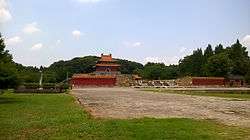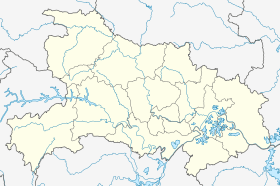Zhongxiang
Zhongxiang (simplified Chinese: 钟祥; traditional Chinese: 鍾祥; pinyin: Zhōngxiáng; Wade–Giles: Chung1-hsiang2) is a county-level city of Jingmen, central Hubei province, People's Republic of China. The name Zhongxiang means "Blessed with propitious omen", and was given to the city by the Jiajing Emperor in the Ming dynasty.
Zhongxiang 钟祥市 Chungsiang | |
|---|---|
County-level City | |
 Mingxianling | |
 Zhongxiang Location in Hubei | |
| Coordinates (Zhongxiang government): 31°10′05″N 112°35′17″E | |
| Country | People's Republic of China |
| Province | Hubei |
| Prefecture-level city | Jingmen |
| Township-level divisions | 1 subdistrict 15 towns 1 township |
| Seat | Yingzhong Subdistrict (郢中街道) |
| Area | |
| • County-level City | 4,488 km2 (1,733 sq mi) |
| • Urban | 175.00 km2 (67.57 sq mi) |
| Elevation | 66 m (217 ft) |
| Population (2010)[2] | |
| • County-level City | 1,022,514 |
| • Density | 230/km2 (590/sq mi) |
| • Urban | 274,000 |
| Time zone | UTC+8 (China Standard) |
| Postal code | 431900 |
| Area code(s) | 0724 |
| Website | http://www.zhongxiang.gov.cn/ |
History
Zhongxiang is one of the cradles of Chu culture. It was the alternate capital of the Chu state in the Spring and Autumn period and the Warring States period.
Because the Jiajing Emperor (r. 1521–1566) of the Ming dynasty was born and had lived in the city before he succeeded to the throne, Zhongxiang, the place where the Chengtian Prefecture (fu) Government Office was located, became one of the three major prefectures directly under the central government. Once on the throne, the Jiajing Emperor controversially had his dead father Zhu Youyuan (1476–1519) retroactively styled as the Gongruixian Emperor; his mother became the Zhangsheng empress dowager. They were buried at a sumptuous mausoleum, knowns as the Xianling Tomb, a few kilometers northeast of Zhongxiang.[4]
During the Jiajing Emperor's reign, a large estate owned by the emperor occupied a significant part of Chengtian Prefecture, and was run by the same eunuch who was in charge of the protection of the mausoleum.[5]
The mausoleum complex is now a tourist site; it was included on the List of UNESCO World Heritage Sites in 2000, as one of the Imperial Tombs of the Ming and Qing Dynasties.[6]
Geography

Zhongxiang, with a total land area of 4,488 square kilometres (1,733 sq mi), is situated in the central part of Hubei. It lies at the north of Jianghan Plain, and the middle reaches of the Han River, with latitude ranging from 30° 42' to 31° 36' N and longitude 112° 07' to 113° 00' E, and a maximum north-south extent of 100.6 km (62.5 mi) and east-west width of 83.5 km (51.9 mi). The urban area is at 66 m (217 ft) above sea level.[7] After the building of the Three Gorges Dam a number of people from the Gaoyang area moved to the area around Zhongxiang. It borders Suizhou to the northeast, Jingshan County to the east, Tianmen to the south, the two districts (urban area) of Jingmen to the west, and Yicheng to the northwest.
Climate
Zhongxiang has a four-season humid subtropical climate (Köppen Cfa), with cold, damp (but comparatively dry), winters, and hot, humid summers. The average annual temperature is 16.12 °C (61.0 °F). July is the hottest month, with an average temperature 27.7 °C (81.9 °F). January is the coldest month, with an average temperature of 3.5 °C (38.3 °F). The coldest temperature ever recorded in Zhongxiang was −15.3 °C (4 °F) on January 30, 1977.
Zhongxiang has abundant precipitation throughout the year, with average precipitation of 972.3 millimetres (38.28 in) every year. Rain and heat are occurring in the same season. Snow is infrequent. Zhongxiang receives plenty of sunshine, with about 1930.8 to 2114.3 hours every year.
| Climate data for Zhongxiang | |||||||||||||
|---|---|---|---|---|---|---|---|---|---|---|---|---|---|
| Month | Jan | Feb | Mar | Apr | May | Jun | Jul | Aug | Sep | Oct | Nov | Dec | Year |
| Record high °C (°F) | 21.1 (70.0) |
24.1 (75.4) |
27.8 (82.0) |
32.8 (91.0) |
35.6 (96.1) |
38.4 (101.1) |
38.6 (101.5) |
38.0 (100.4) |
38.0 (100.4) |
33.4 (92.1) |
28.9 (84.0) |
21.6 (70.9) |
38.6 (101.5) |
| Average high °C (°F) | 7.7 (45.9) |
10.0 (50.0) |
14.2 (57.6) |
21.2 (70.2) |
26.3 (79.3) |
29.4 (84.9) |
31.8 (89.2) |
31.7 (89.1) |
27.4 (81.3) |
22.1 (71.8) |
15.9 (60.6) |
10.1 (50.2) |
20.7 (69.2) |
| Daily mean °C (°F) | 3.5 (38.3) |
5.6 (42.1) |
9.7 (49.5) |
16.4 (61.5) |
21.4 (70.5) |
25.2 (77.4) |
27.7 (81.9) |
27.1 (80.8) |
22.6 (72.7) |
17.2 (63.0) |
11.2 (52.2) |
5.8 (42.4) |
16.1 (61.0) |
| Average low °C (°F) | 0.3 (32.5) |
2.2 (36.0) |
6.1 (43.0) |
12.6 (54.7) |
17.6 (63.7) |
21.6 (70.9) |
24.5 (76.1) |
23.9 (75.0) |
19.1 (66.4) |
13.7 (56.7) |
7.7 (45.9) |
2.4 (36.3) |
12.6 (54.8) |
| Record low °C (°F) | −15.3 (4.5) |
−7.4 (18.7) |
−1.8 (28.8) |
0.0 (32.0) |
8.4 (47.1) |
12.7 (54.9) |
17.9 (64.2) |
16.1 (61.0) |
11.0 (51.8) |
2.9 (37.2) |
−2.6 (27.3) |
−8.4 (16.9) |
−15.3 (4.5) |
| Average precipitation mm (inches) | 23.6 (0.93) |
32.3 (1.27) |
56.1 (2.21) |
80.9 (3.19) |
122.8 (4.83) |
137.3 (5.41) |
169.8 (6.69) |
123.5 (4.86) |
88.8 (3.50) |
74.0 (2.91) |
45.0 (1.77) |
18.2 (0.72) |
972.3 (38.29) |
| Average precipitation days (≥ 0.1 mm) | 6.7 | 7.8 | 11.4 | 11.4 | 11.6 | 11.9 | 11.5 | 10.4 | 9.8 | 9.9 | 7.6 | 6.3 | 116.3 |
| Source: Weather China[7] | |||||||||||||
Administrative divisions
Zhongxiang is administratively equal to a county and is divided into 17 township-level division: 1 subdistrict, 15 towns, and 1 township.[1][2][8][9]
- Yingzhong Subdistrict (郢中街道), 49 square kilometres (19 sq mi), 170,991
- Yangzi (洋梓镇), 403 square kilometres (156 sq mi), 68,341
- Changshou (长寿镇), 275 square kilometres (106 sq mi), 27,535
- Fengle (丰乐镇), 162 square kilometres (63 sq mi), 68,700
- Huji (胡集镇), 393 square kilometres (152 sq mi), 129,891
- Shuanghe (双河镇), 235 square kilometres (91 sq mi), 46,220
- Linkuang (磷矿镇), 219 square kilometres (85 sq mi), 47,092
- Wenji (文集镇), 128 square kilometres (49 sq mi), 44,405
- Lengshui (冷水镇), 314 square kilometres (121 sq mi), 47.393
- Shipai (石牌镇), 295 square kilometres (114 sq mi), 84,296
- Jiukou (旧口镇), 201 square kilometres (78 sq mi), 103,514
- Chaihu (柴湖镇), 225 square kilometres (87 sq mi), 95,663
- Changtan (长滩镇), 153 square kilometres (59 sq mi), 20,338
- Dongqiao (东桥镇), 256 square kilometres (99 sq mi), 24,085
- Kedian (客店镇), 293 square kilometres (113 sq mi), 14,581
- Zhangji (张集镇), 289 square kilometres (112 sq mi), 22,805
- Jiuli Township (九里乡), 99 square kilometres (38 sq mi), 16,718
Economy
Industry
After years of construction, an industrial structure has been initially formed by the development of machinery, building materials, chemicals, light industry, textile and food industry. Among more than 600 industrial products, 20 of them entered international markets, 45 species are at national leading level and 130 species are at the leading level in Hubei province.
As of 2009, 265 main industrial enterprises contribute 19.563 billion yuan to the city's industrial output value with a sales value of 18.9747 billion yuan, export delivery value of 307.16 million yuan. [10]
Agriculture
ZhongXiang has diversified terrain and appropriate subtropical monsoon climate. The total land area is 4760 square kilometer, with 1300 square kilometer cultivated land 300 square kilometer uncultivated land. Area for forest, waters and pasture is 1300 square kilometer, 50 square kilometer and 1200 square kilometer respectively. The total amount of freshwater resources is 5104.2 billion cubic meters.
With diversified terrain, there are different kinds of agricultural products. Main agricultural products include grains, cotton, oil, pigs, poultry, fruits, vegetables, and edible fungus. Main crops includes rice, wheat, corn, soybean silkworm peas, and cotton, rapeseed, peanut, sesame, vegetables, citrus fruit, pears, grape, red jujube, peaches, tea, etc.
In 2009, the municipal agricultural output value reached 8.2 billion yuan. Total agricultural production includes 816500 tons total grain output, 144100 tons cotton output, 120700 tons oil production; 92000 tons animal production; 110000 tons output of aquatic products; 193300 tons fruit production. [11]
Sights
- Xianling Tomb (显陵)
- Mountain Dahong National Scenic Area (大洪山国家森林公园)
- Huangxian Cave (黄仙洞) famous for its karst landform
- Wenxia Reservoir (温峡水库)
References
- 张林 (21 November 2016). 行政区划 [Administrative Divisions] (in Chinese). Zhongxiang People's Government. Retrieved 10 August 2018.
街道办事处1个 镇15个 乡1个{...}街道办事处镇、乡名 称 合 计 郢中街道办事处 洋梓镇 长寿镇 丰乐镇 胡集镇 双河镇 磷矿镇 文集镇 冷水镇 石牌镇 旧口镇 柴湖镇 长滩镇 东桥镇 客店镇 张集镇 九里乡 其它(场、库){...}面 积 (平方千米) 4488
- 钟祥市历史沿革 [Zhongxiang City Historical Development] (in Chinese). XZQH. 6 August 2014. Retrieved 10 August 2018.
1996年,钟祥市面积4488平方千米,{...}2010年第六次人口普查,钟祥市常住总人口1022514人,其中:郢中街道190147人,洋梓镇52466人,长寿镇28033人,丰乐镇64531人,胡集镇127586人,双河镇38159人,磷矿镇41410人,文集镇40286人,冷水镇45373人,石牌镇84301人,旧口镇96356人,柴湖镇95169人,长滩镇18311人,东桥镇24293人,客店镇13263人,张集镇22034人,九里乡17163人,钟祥市官庄湖管理区12689人,南湖原种场7253人,罗汉寺种畜场2304人,温峡水库1015人,石门水库255人,黄坡水库117人。
- Ministry of Housing and Urban-Rural Development, ed. (2019). China Urban Construction Statistical Yearbook 2017. Beijing: China Statistics Press. p. 66. Retrieved 11 January 2020.
- Eric N. Danielson, "The Ming Ancestor Tomb"
- Shih-shan Henry Tsai, The Eunuchs in the Ming Dynasty. SUNY Press, 1996. ISBN 0-7914-2687-4. Partial text on Google Books. P. 168
- Imperial Tombs of the Ming and Qing Dyansties. See in particular the China's official nomination document for the UNESCO, with a large chapter on Xianling.
- 钟祥城市介绍 (in Chinese). Weather China. Retrieved 2013-01-02.
- 2011年统计用区划代码和城乡划分代码:钟祥市 (in Chinese). National Bureau of Statistics of the People's Republic of China. Retrieved 2013-01-02.
- 2017年统计用区划代码和城乡划分代码:钟祥市 [2017 Statistical Area Numbers and Rural-Urban Area Numbers: Zhongxiang City]. National Bureau of Statistics of the People's Republic of China. 2017. Retrieved 10 August 2018.
统计用区划代码 名称 420881001000 郢中街道办事处 420881100000 洋梓镇 420881101000 长寿镇 420881102000 丰乐镇 420881103000 胡集镇 420881104000 双河镇 420881105000 磷矿镇 420881106000 文集镇 420881107000 冷水镇 420881108000 石牌镇 420881109000 旧口镇 420881110000 柴湖镇 420881111000 长滩镇 420881112000 东桥镇 420881113000 客店镇 420881114000 张集镇 420881200000 九里乡 420881400000 湖北钟祥经济开发区 420881450000 钟祥市官庄湖管理区 420881451000 南湖原种场 420881452000 罗汉寺种畜场 420881453000 双桥原种场 420881454000 东岳种畜场 420881455000 康桥湖农场 420881456000 大口林场 420881457000 盘石岭林场 420881458000 温峡水库 420881459000 石门水库 420881460000 黄坡水库 420881461000 湖北钟祥胡集经济技术开发区
- "Archived copy". Archived from the original on July 7, 2011. Retrieved February 25, 2011.CS1 maint: archived copy as title (link)
- "Archived copy". Archived from the original on July 7, 2011. Retrieved February 25, 2011.CS1 maint: archived copy as title (link)